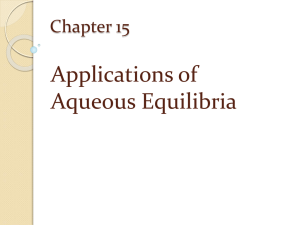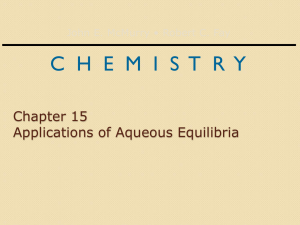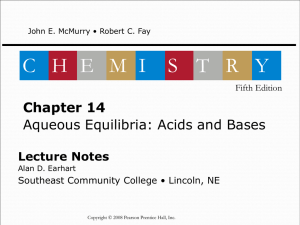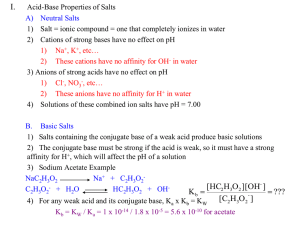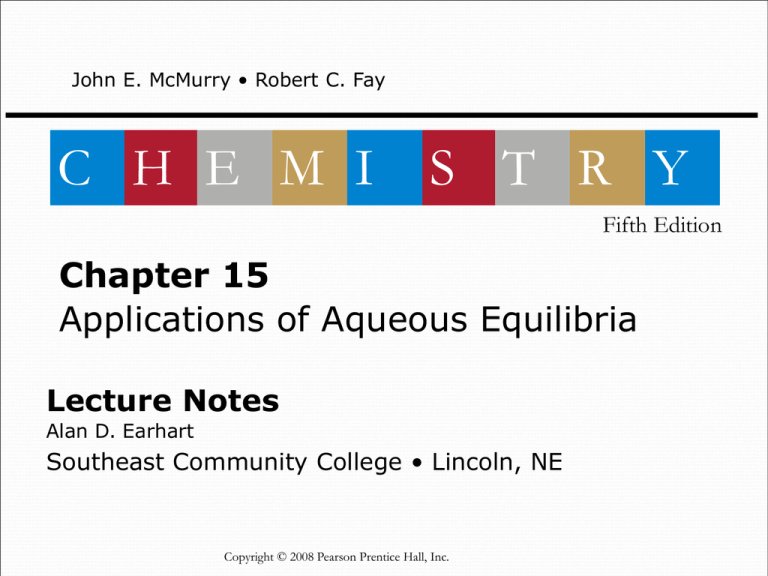
John E. McMurry • Robert C. Fay
C H E M I
S T R Y
Fifth Edition
Chapter 15
Applications of Aqueous Equilibria
Lecture Notes
Alan D. Earhart
Southeast Community College • Lincoln, NE
Copyright © 2008 Pearson Prentice Hall, Inc.
Neutralization Reaction
General Formula
Acid + Base - Water + Salt
Neutralization Reactions
Strong Acid-Strong Base
HCl(aq)
+
NaOH(aq)
H2O(l) +
NaCl(aq)
Assuming complete dissociation:
H1+(aq) + OH1-(aq)
H2O(l)
H3O1+(aq) + OH1-(aq)
2H2O(l)
or
(net ionic equation)
After neutralization: pH = 7
Copyright © 2008 Pearson Prentice Hall, Inc.
Chapter
15/3
Strong acid-Strong base
neutralization
When the number moles of acid and base are mixed
together
[H3O+] = [-OH] = 1.0 x 10-7M
Reaction proceeds far to the right
Neutralization Reactions
Weak Acid-Strong Base
CH3CO2H(aq)
+
NaOH(aq)
H2O(l)
+
NaCH3CO2(aq)
Assuming complete dissociation:
CH3CO2H(aq) + OH1-(aq)
H2O(l) + CH3CO21-(aq)
(net ionic equation)
After neutralization: pH > 7
Copyright © 2008 Pearson Prentice Hall, Inc.
Chapter
15/5
Weak acid-strong base
neutralization
Neutralization of any weak acid by a strong base goes 100%
to completion
-OH has a great infinity for protons
Neutralization Reactions
Strong Acid-Weak Base
HCl(aq)
+ NH3(aq)
NH4Cl(aq)
Assuming complete dissociation:
H1+(aq) + NH3(aq)
NH41+(aq)
or
H3O1+(aq) + NH3 (aq)
H2O(l) +
NH41+(aq)
(net ionic equation)
After neutralization: pH < 7
Copyright © 2008 Pearson Prentice Hall, Inc.
Chapter
15/7
Strong acid-weak base
neutralization
Neutralization of any weak base by a strong acid goes 100%
to completion
H3O+ has a great infinity for protons
Neutralization Reactions
Weak Acid-Weak Base
CH3CO2H(aq) + NH3(aq)
NH4CH3CO2(aq)
CH3CO2H(aq) + NH3(aq)
NH41+(aq) + CH3CO21-(aq)
(net ionic equation)
After neutralization: pH = ?
Copyright © 2008 Pearson Prentice Hall, Inc.
Chapter
15/9
Weak acid-weak base
neutralization
Less tendency to proceed to completion than neutralization
involving strong acids and strong bases
The Common-Ion Effect
Common-Ion Effect: The shift in the position of an equilibrium
on addition of a substance that provides an ion in common
with one of the ions already involved in the equilibrium.
• Example of Le Chatelier’s principle
• E.g Adding HCl and NaOH to a solution of acetic acid
would shift the equilibrium to which direction?
CH3CO2H(aq) + H2O(l)
H3O1+(aq) + CH3CO21-(aq)
Copyright © 2008 Pearson Prentice Hall, Inc.
Chapter
15/11
The Common-Ion Effect
Le Châtelier’s Principle
CH3CO2H(aq) + H2O(l)
H3O1+(aq) + CH3CO21-(aq)
The addition of acetate ion to a solution of acetic acid
suppresses the dissociation of the acid. The equilibrium shifts
to the left.
Copyright © 2008 Pearson Prentice Hall, Inc.
Chapter
15/12
The Common-Ion Effect
The pH of 0.10 M acetic acid is 2.89. Calculate the pH of a solution that
is prepared by dissolved 0.10 mol of acetic acid and 0.10 mol sodium
acetate in enough water to make 1.00 L of solution. Ka = 1.8 x 10-5
CH3CO2H(aq) + H2O(l)
H3O1+(aq) + CH3CO21-(aq)
[H3O1+][CH3CO21-]
Ka =
[CH3CO2H]
Copyright © 2008 Pearson Prentice Hall, Inc.
Chapter
15/14
Example
In 0.15 M NH3, the pH is 11.21 and the percent dissociation
is 1.1%. Calculate the concentrations of NH3, pH and
percent dissociation of ammonia in a solution that is 0.15M
and 0.45 MNH4Cl
Buffer Solutions
Buffer Solution: A solution which contains a weak acid and
its conjugate base and resists drastic changes in pH.
Weak acid
For
Example:
+
CH3CO2H + CH3CO21HF + F1NH41+ + NH3
H2PO42- + HPO42-
Conjugate base
Copyright © 2008 Pearson Prentice Hall, Inc.
Chapter
15/16
Buffer Solutions
Add a small amount of base (-OH) to a buffer solution
Acid component of solution neutralizes the added base
Add a small amount of acid (H3O+) to a buffer solution
Base component of solution neutralizes the added acid
The addition of –OH or H3O+ to a buffer solution will
change the pH of the solution, but not as drastically as the
addition of –OH or H3O+ to a non-buffered solution
Buffer Solutions
CH3CO2H(aq) + H2O(l)
H3O1+(aq) + CH3CO21-(aq)
Weak acid
Conjugate base
(NaCH3CO2)
Addition of OH1- to a buffer:
CH3CO2H(aq) +
OH1-(aq)
100%
Copyright © 2008 Pearson Prentice Hall, Inc.
H2O(l) + CH3CO21-(aq)
Chapter
15/18
Buffer Solutions
Addition of H3O1+ to a buffer:
CH3CO2
1-(aq)
+ H3
O1+(aq)
100%
H2O(l) + CH3CO2H(aq)
Example
pH of human blood (pH = 7.4) controlled by conjugated
acid-base pairs (H2CO3/HCO3-)
With addition of H3O+
With addition of -OH
Buffer Solutions
Buffer capacity
A measure of the amount of acid or base that a buffer
solution can absorb without a significant change in pH
Depends on how much weak acid and conjugated base is
present
For equal volume of solution, the more concentration the
solution, the greater the buffer capacity
For solution with the same concentration, increasing the
volume increases the buffer capacity
Example
Calculate the pH of the buffer that results from mixing
60.0mL of 0.250M HCHO2 and 15.0 mL of 0.500M
NaCHO2
Ka = 1.8 x 10-4
Example
Calculate the pH of 0.100L of a buffer solution that is
0.25M in HF and 0.50 M in NaF,
Ka = 6.3 x 10-4
What is the change in pH on addition of 0.002 mol HCl
What is the change in pH on addition of 0.010 moles KOH
Calculate the pH after addition of 0.080 moles HBr
Example
calculate the pH of a 50.0 ml buffer solution that is 0.50 M
in NH3 and 0.20 M NH4Cl. For ammonia, pKb = 4.75
Calculate the pH after addition of 150.0 mg HBr
The Henderson-Hasselbalch
Equation
CH3CO2H(aq) + H2O(l)
H3O1+(aq) + CH3CO21-(aq)
Weak acid
Conjugate base
Acid(aq) + H2O(l)
Ka =
[H3O1+][Base]
H3O1+(aq) + Base(aq)
[H3O1+] = Ka
[Acid]
Copyright © 2008 Pearson Prentice Hall, Inc.
[Acid]
[Base]
Chapter
15/26
The Henderson-Hasselbalch
Equation
[Acid]
[H3O1+] = Ka
[Base]
[Acid]
-log([H3O1+]) = -log(Ka) - log
[Base]
[Base]
pH = pKa + log
[Acid]
Copyright © 2008 Pearson Prentice Hall, Inc.
Chapter
15/27
Example
Calculate the pH of a buffer solution that is 0.50 M in
benzoic acid (HC7H5O2) and 0.150 M in sodium benzoate
(NaC7H5O2). Ka = 6.5 x 10-5
How would you prepare a NaHCO3-Na2CO3 buffer solution
that has pH = 10.40 Ka2 = 5.6 x 10-11

